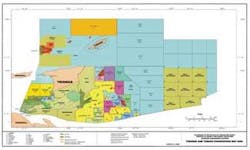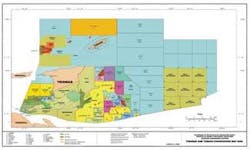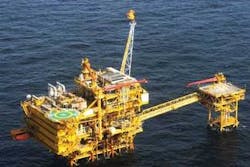Trinidad remains critical to US energy supply
Judy Maksoud, International Editor
Trinidad’s story is still unfolding. There are multiple large exploration and development opportunities in Trinidad that involve both gas and oil, and a fair number of international operators are pursuing sizable projects in the region.
International operators
British Petroleum is one of Trinidad’s bigger investors. The company holds exploration and production licenses covering 904,000 acres (365,836 hectares) off the east coast. The majority of its upstream assets are owned by BP Trinidad & Tobago (bpTT), in which BP and Repsol YPF have a 70/30 partnership.
The company’s offshore infrastructure comprises 17 producing platforms, including Cannonball, which lies 35 km (22 mi) off the coast in 70 m (231 ft) water depth and processes about 800 MMcf/d of gas. According to BP, the $250-million Cannonball hub, which produced first gas in March 2006, is the first platform to be designed and constructed in Trinidad and Tobago. Over 40 nationals were trained during the design and construction stages, BP says, with a local labor force contributing 85% of the total fabrication hours.
“This is a project of many firsts for bpTT,” says Robert Riley, CEO of bpTT. “Cannonball has built a legacy of sustainability through the creation of distinct indigenous businesses in two sectors in Trinidad and Tobago - platform design and engineering and fabrication. It also demonstrates our capacity to deliver a major project from start to finish in Trinidad and Tobago.”
Another milestone of the bpTT Cannonball project is that it introduced the hub and spoke field development design to the region.
British Gas also continues to invest in its acreage offshore Trinidad. In mid-July 2006, BG Group and partner Chevron delivered first gas from the Dolphin Deep development to the processing facilities at Beachfield on the southeast coast. Dolphin Deep is the country’s first subsea development.
The BG-operated field is 83 km (52 mi) off Trinidad in the East Coast Marine Area (ECMA). Gas production from the two Dolphin Deep wells is expected to reach a maximum rate of 250 MMcf/d and will be delivered to Atlantic LNG (A-LNG) in Port Fortin on the southwest coast via the 95-km (59-mi) offshore Dolphin to Beachfield pipeline.
The ECMA contains four gas fields: Dolphin, Dolphin Deep, Starfish, and Manatee.
The Manatee field, discovered in January 2005, is part of a cross-border accumulation that stretches into neighboring Venezuela. Monetization options for Manatee gas are still under review. Exploration drilling plans within the ECMA also are being evaluated.
In January 2007, BG and partner Chevron entered into heads of agreement with the National Gas Co. of Trinidad and Tobago Ltd. to supply 220 MMcf/d of gas for up to 15 years beginning on Jan. 1, 2009.
The partners reached a gas sales agreement in late May to supply 220 MMcf/d of gas for 11 years. Delivery is expected to begin in 2009.
BHP Billiton, operator of the Greater Angostura oil and gas field in block 2(c) achieved first oil in Dec. 2004, with first production in Jan. 2005. Angostura represents the first oil production from the northeast coast.
Today, the bulk of the produced gas is being re-injected into Angostura reservoirs to optimize oil production from the field, with a portion being used to fuel operations on the processing platform. In the second phase of the Angostura project, BHP plans to commercialize the field’s significant gas resources.
Now, BHP’s focus is on optimizing production, according to Vincent Pereira, president of BHP Billiton Trinidad and Tobago. Some of the offshore work targets block 3(a), where BHP found oil last with the shallow-water Ruby-1 exploration well. Ruby-1 is 48 km (30 mi) off the northeast coast and 8 km (5 mi) east of the central processing platform for the Greater Angostura field on block 2(c).
“We continue our appraisal efforts following the Ruby discovery,” Pereira says. “There will be one additional exploration well on the block this year.”
Other drilling will include participation in one exploration well, two appraisal wells, four development wells, and two recompletions in 2007, Pereira says.
The one appraisal and two development wells are associated with BHP’s next phase of development on block 2(c). The gas phase is expected to come online in 2010, Pereira says.
Canada’s Talisman Energy Inc. is one of BHP’s partners in Trinidad. In a webcast held in May 2007, the company broadcast its pre-development plans for the Angostura Phase 2 gas development project.
According to Jim Buckee, Talisman president and CEO, “A heads of agreement has been signed with Trinidad and Tobago’s National Gas Co. (NGC) to sell gas at initial rates of 220 MMcf/d (6.23 MMcm/d) starting in 2010.”
Buckee says negotiations are under way with NGC on the gas sales contract.
The Canadian firm holds a 25% operating interest in Angostura and a 36% interest in block 2(c). Talisman also has interests in offshore block 3(a).
In the first three months of this year, Talisman spent $18 million on exploration and $7 million on development in Trinidad. The company plans to invest $59.2 million in Trinidad and Tobago this year to drill up to seven exploration wells and four development wells.
Newcomer in the game
Calgary’s Canadian Superior Energy Inc. is just entering the exploration phase of its program in Trinidad. Greg Noval, the company chairman, is excited about the drilling opportunities the company is pursuing. “Trinidad is one of the most coveted oil and gas basins in the world today,” Noval says.
Drilling is to begin this month on Canadian Superior’s acreage.
The company has contracted theKan Tan IV semisubmersible, which will drill three wells on separate natural gas prospects, Victory, Bounty, and Endeavour, approximately 97 km (60 mi) off the east coast of Trinidad.
“These are large structures and individually have very significant potential. It’s quite an exciting program for Canadian Superior,” says Mike Coolen, Canadian Superior president and COO.
Of the first three upcoming drilling locations on the company’s Intrepid block 5(c), two have been surveyed, and the third is scheduled for surveying in 3Q 2007.
Canadian Superior also is planning future investment in the country. “We are looking to expand our land holding offshore Trinidad and Tobago,” Noval says.
The news from within
In an exclusive discussion withOffshore, the Ministry of Energy - Resource Management and LNG and Export Divisions, talked about the future of Trinidad’s production.
According to the Ministry, last year, domestic demand was 1.5 bcf/d of gas, and LNG demand was 2.1 bcf/d, totaling 3.6 bcf/d over all. Annual production for 2006 was 3.9 bcf.
It is forecast that over the next five years, the most likely increases in demand will occur during 2009-2010, primarily as a result of the commissioning of new metals, fertilizers, and other gas-based petrochemical plants that will require additional gas volumes of about 700 MMcf/d.
With these additional demands, the Ministry said, the country’s production could increase to 5 bcf/d by the end of 2011. Trinidad and Tobago is currently replacing the reserves as a result of increases in production by bringing new sources of natural gas onstream. By the end of 3Q 2007, several exploration prospects identified as gas bearing will be drilled.
PetroCanada will drill in block 22 in the North Coast Marine Area, and Canadian Superior will drill exploration wells in block 5(c), which is adjacent to areas now producing gas. The companies that will undertake the drilling program have assigned a very high chance of success, and the Ministry expects several tcf of gas to be discovered.
Additionally, several gas prone areas were offered competitively, the Ministry said, noting that it should be understood that this is a generally accepted means of replacing resources and that Trinidad and Tobago is very active in this area.
The country last published figures for gas reserves as of Jan. 1, 2005. Those figures indicate risked proved reserves of 18.77 tcf, probable reserves of 5.37 tcf, and possible reserves of 1.54 tcf. In addition, unrisked identifiable leads and prospects were estimated at 32 tcf, with additional unidentified resources in the basin amounting to an additional 28 tcf, the Ministry said.
Meanwhile, seismic surveys continue to evaluate the country’s offshore.
In 2005, Veritas acquired 3D seismic data for Anadarko (Kerr McGee) and BP. Anardarko will drill its first well based on this data in June or July. According to the Ministry, this acreage looks promising.
An earlier Veritas survey in 2003 gathered 12,300 line km (7,643 mi) in the Deep Atlantic area. GXTechnology Corp. has reprocessed some of the data. According to the Ministry, the reprocessed data and the GXT-acquired Caribe Span data will be used to execute a study aimed at refining exploration concepts in the Trinidad and Tobago Deep Atlantic area.
Additional surveys and exploration will be planned following the country’s latest bid round at the end of 2006, the results of which have recently been announced.
In Jan. 2006, the Trinidad government put eight onshore/nearshore blocks and three shallow-water blocks out for bid.
Since 1995, the government of the Republic of Trinidad and Tobago (GORTT) has been using a production-sharing arrangement (PSA) under which the GORTT was responsible for paying the operating companies’ taxes. Beginning in 2005/2006, GORTT is no longer responsible for payment of the companies taxes, the Ministry said. Instead, the companies pay Petroleum Profits Tax and Unemployment Levy, Green Fund Levy, and Withholding Tax, which the GORTT is responsible for other payments in lieu of Supplemental Petroleum Tax, Petroleum Impost, Royalty, and Petroleum Production Levy.
In the competitive bid rounds, companies are required to submit proposals for the Ministry’s share of profit petroleum on the basis of a production/price matrix. While it was contemplated in the matrix of the previous PSAs that the price of oil and gas would rise, the actual rate at which it rose was exceptional. GORTT conducted a review of this arrangement and determined that the production/price table would have to be revised to reflect today’s and future prices in order for the country to capture the optimum economic rent. This was to be achieved with an overall revision of the price classes with a formula based Price Class for the last tranche, the Ministry said.
Trinidad and Tobago endorses risk-based verification
Late in 2006, the Republic of Trinidad officially recognized the world’s first set of publicly accessible risk-based verification standards produced by DNV as part of its safety, health, and environmental approval regime.
To evaluate individual schemes, the ministry communicated with the Minerals Management Service in the US, the Petroleum Safety Authority in Norway, and the Health and Safety Executive in the UK as well as other internationally recognized certified verification agents.
“We are therefore very satisfied that Trinidad and Tobago’s authorities now have fully endorsed DNV’s risk-based verification standards and methodology as the verification standard for Trinidad and Tobago,” says Graeme A.E. Pirie, recently appointed head of DNV Energy Trinidad and Tobago.
DNV has carried out a number of verification projects in Trinidad, including:
- Verification of the NGC cross-island pipeline project. At 56 in. (142.2 cm) outer diameter and 76 km (47 mi) long, this pipeline is the largest and longest in the Caribbean and the only pipeline of this diameter in the western hemisphere.
- Verification of the BGTTL Beachfield onshore gas condensate processing facility (the first processing facility to be independently verified in Trinidad)
- Verification of the bpTT Mango, Cashima, Amherstia, and Savonette field development process facilities (the first process facilities to be independently verified for bpTT)
- Verification of the BGTTL North Coast Marine Area 3C (Poinsettia) development, which is the largest field development project independently verified to date in Trinidad
“DNV is now highly regarded and well positioned in Trinidad to expand on our initial certified verification agent achievement. This will play a significant role in our future growth plans, enabling us to develop local capabilities and establish a greater local presence in the Republic of Trinidad and Tobago,” Pirie says.



